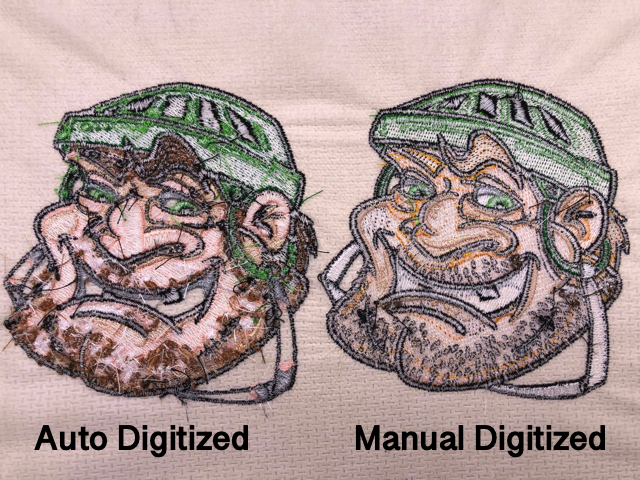Ideal Digitizing for Embroidery: Boost Your Projects
Ideal Digitizing for Embroidery: Boost Your Projects
Blog Article
Mastering the Needlework Digitizing Refine: Your Ultimate Overview
Needlework digitizing is a careful craft that calls for precision and experience to translate elaborate styles right into digital styles for machine embroidery. As artisans embark on this journey to understand the embroidery digitizing procedure, a thorough understanding of the essentials sets the structure for excellence. Beyond the basic understanding lies a realm of sophisticated software, specialized devices, and nuanced techniques waiting to be discovered. By delving right into the nuances of digitizing, one can unlock a world of creative possibilities and boost their embroidery tasks to brand-new heights.

Comprehending Embroidery Digitizing Essentials
Embroidery digitizing basics form the structure whereupon intricate layouts are converted right into machine-readable layouts for specific stitching. This preliminary action in the needlework digitizing procedure is critical for guaranteeing that the last stitched item is a faithful depiction of the original design. Comprehending needlework digitizing fundamentals includes understanding crucial principles such as stitch kinds, sew direction, density, rug, and draw settlement.
Sew kinds play an essential duty in identifying the aesthetic and textural outcome of the embroidered design. By picking the appropriate stitch kind, whether it be satin, fill, or running stitch, digitizers can accomplish the desired impact and improve the overall quality of the embroidery. In addition, stitch direction influences the circulation and dimension of the style, while thickness identifies the spacing and insurance coverage of the stitches.
Additionally, padding sewing offers stability to the design by securing the textile and protecting against distortion throughout the needlework procedure. Pull payment is another vital consideration to neutralize the all-natural tendency of textile to agreement when stitched. Understanding these embroidery digitizing essentials is essential for producing professional-quality embroidered items.
Selecting the Right Digitizing Software
Selecting the suitable digitizing software application is a vital choice that significantly affects the effectiveness and quality of the needlework digitizing procedure. Digitizing for Embroidery. When selecting the right digitizing software application, it is necessary to take into consideration variables such as the intricacy of layouts you prepare to create, the user-friendliness of the software, the level of client support offered, and the compatibility with your needlework equipment
There are different digitizing software program choices available on the market, varying from standard programs for newbies to advanced software for professional digitizers. Some preferred choices include Wilcom EmbroideryStudio, Hatch Needlework Software Application, and PulseID. These software application bundles use a variety of devices and attributes to help you produce intricate designs easily.
Before deciding, it is suggested to explore the various More about the author software options via free trials or trials to determine which one ideal suits your needs. Additionally, checking out evaluations and looking for referrals from knowledgeable digitizers can offer beneficial insights into the strengths and weaknesses of each software application bundle (Digitizing for Embroidery). By meticulously examining your requirements and comparing the functions of different digitizing software program, you can make an informed option that enhances your needlework digitizing process
Digitizing Devices and Techniques

Optimizing Design Setup for Needlework
Mastering the complexities of style settings is essential in achieving ideal results in the needlework digitizing procedure, structure upon the foundation laid by comprehending digitizing tools and techniques. When optimizing layout setups for needlework, it is necessary to think about elements such as stitch kind, thickness, rug, pull compensation, and enrollment. Registration setups line up different components of the style accurately, keeping general style integrity.

Troubleshooting Common Digitizing Issues
When encountering typical digitizing problems throughout the needlework process, it is necessary to comprehend the origin and implement effective services immediately. One usual problem is stitch density problems, where stitches might be too thick, creating the material to pucker, or also sparse, bring about gaps in the design. Readjusting the stitch density setups in the digitizing software can aid solve this issue.
Another frequent challenge is thread breaks throughout the embroidery process. This can take place as a result of different reasons such as wrong tension settings, dull needles, or utilizing low-grade string. Guaranteeing appropriate maintenance of the embroidery maker, consisting of normal needle adjustments and stress modifications, can decrease the incident of string breaks.
Furthermore, layout enrollment mistakes can lead to misaligned aspects within the embroidery design. Inspecting the style positioning in the digitizing software program and making required modifications before stitching can aid in preventing this problem. By attending to these usual digitizing concerns promptly and successfully, you can make certain a smoother needlework process and premium completed products.
Conclusion
Finally, mastering the needlework digitizing process needs a solid understanding of the essentials, the ideal choice of software, and knowledge of tools and strategies. Enhancing layout settings and troubleshooting typical digitizing problems are critical action in making certain top notch needlework outcomes. By complying with these steps carefully, one can accomplish accuracy Your Domain Name and effectiveness in the digitizing procedure.
Report this page